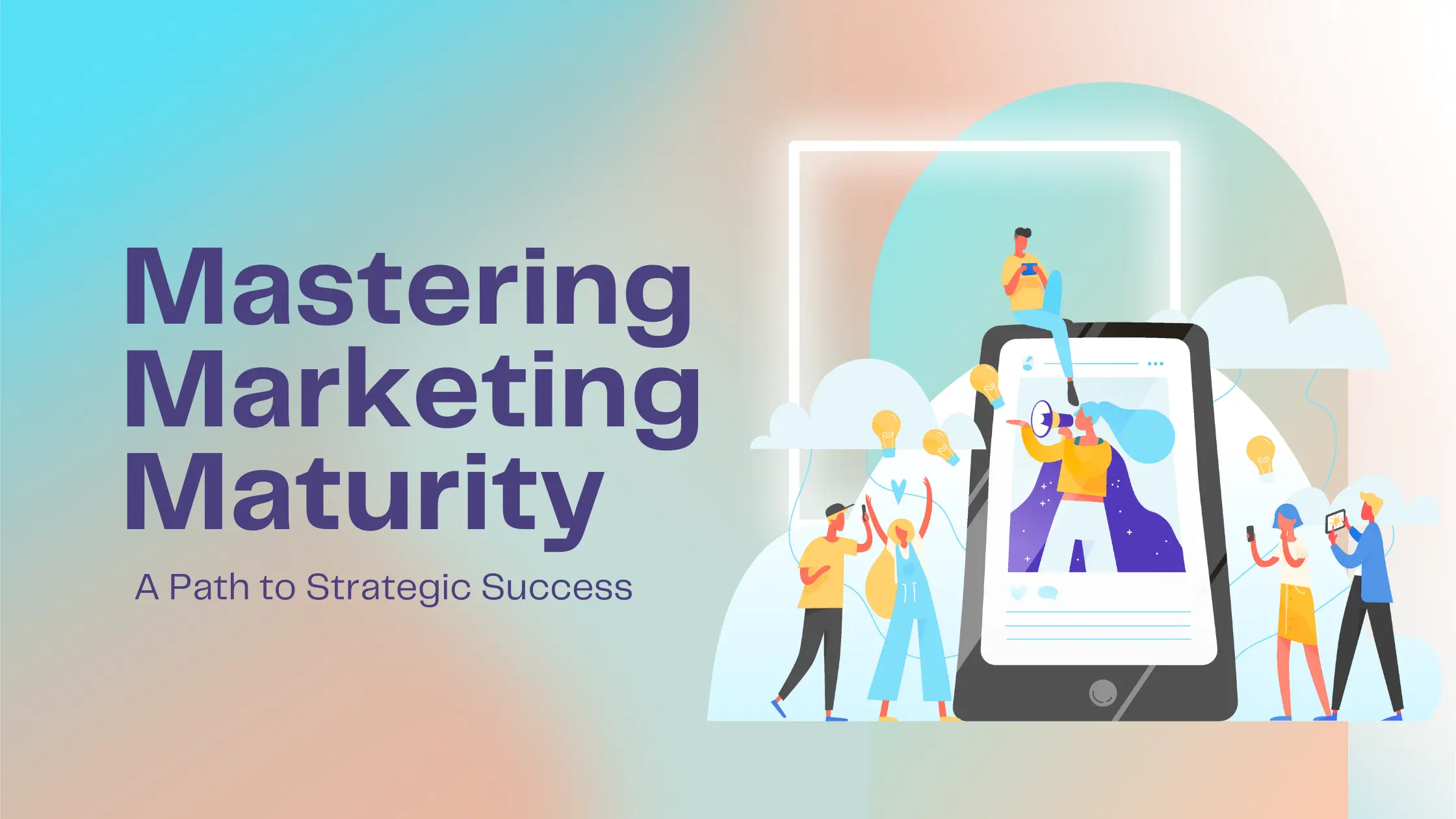Marketing has evolved rapidly in recent years, significantly changing how businesses connect with their audiences. Understanding and enhancing your marketing maturity is crucial for staying competitive and effectively meeting customer needs. This comprehensive guide explores the concept of marketing maturity, its stages, and actionable steps to advance your organization’s marketing efforts for greater success.
What is Marketing Maturity?
Marketing maturity refers to the progression of an organization’s marketing capabilities from basic, ad-hoc efforts to sophisticated, integrated strategies. It signifies a shift from a seller-centric approach to a buyer-centric one, positioning marketing as a key driver of strategic growth.
Key Components of Marketing Maturity
- Processes: The efficiency and effectiveness of marketing operations.
- Tactics: The strategies employed to reach and engage customers.
- Technology: The tools and platforms supporting marketing activities.
- Data: The quality and use of data to inform decisions.
- Outcomes: The results achieved from marketing efforts.
Benefits of Marketing Maturity
- Improved Efficiency: Streamlined processes and better use of technology.
- Enhanced Customer Engagement: More personalized and relevant communications.
- Strategic Growth: Marketing as a key driver of business success.
- Competitive Advantage: Staying ahead of competitors through advanced marketing practices.
The Stages of Marketing Maturity
Marketing maturity is typically divided into several stages, each representing a different level of sophistication and capability.
Stage 1: Ad-Hoc Marketing
- Characteristics: Chaotic, unstructured efforts; often reliant on external agencies.
- Challenges: Inconsistent results, lack of strategic direction.
- Opportunities: Identify quick wins through basic marketing activities.
Stage 2: Repeatable Marketing
- Characteristics: Processes are repeatable, some methods are archived.
- Challenges: Limited scalability, inconsistent integration.
- Opportunities: Develop a more consistent approach, begin to leverage past results.
Stage 3: Defined Marketing
- Characteristics: Established processes, marketing department with various expertise.
- Challenges: Need for better alignment with sales, more sophisticated tools.
- Opportunities: Enhance collaboration, invest in advanced marketing technologies.
Stage 4: Managed Marketing
- Characteristics: Prominent role in the organization, monitored results.
- Challenges: Ensuring continuous improvement, adapting to market changes.
- Opportunities: Utilize dashboards and KPIs to drive performance.
Stage 5: Optimized Marketing
- Characteristics: Fine-tuned processes, deep management insights.
- Challenges: Maintaining high performance, innovating continuously.
- Opportunities: Achieve high business value through detailed process improvement.
Frameworks and Models of Marketing Maturity
Several models and frameworks can help organizations measure and grow their marketing maturity. These frameworks typically assess various dimensions such as processes, technology, and outcomes to provide a comprehensive view of an organization’s marketing capabilities.
Chapman Bright’s Marketing Maturity Growth Model
Chapman Bright’s model divides marketing maturity into five stages: Ad-Hoc, Repeatable, Defined, Managed, and Optimizing. It focuses on the relationship between maturity and business value, represented as an S-curve, highlighting the effort required and the potential impact at each stage.
Key Focus Areas:
- Communication: Thought leadership, content relevance, and timing.
- Channels: Multichannel strategies and channel optimization.
- Sales Enablement: Integration with sales and lead nurturing.
- Customer Insights: CRM utilization and customer engagement.
- Marketing Intelligence: Competitive analysis and predictive analytics.
Oracle’s Path to Marketing Maturity
Oracle’s framework emphasizes the importance of aligning organizational priorities, collaboration, and technologies to achieve a customer-centric approach. It outlines four levels of marketing maturity:
- Broadcast Marketing: Automation of marketing tasks for cost-effective customer acquisition.
- Responsive Marketing: Engaging customers across multiple channels with personalized communications.
- Relationship Marketing: Building strong cross-team collaboration and strategic partnerships.
- Lifecycle Marketing: Delivering a unified brand experience across all customer touchpoints.
MarketingProfs’ Stages of Marketing Maturity
MarketingProfs identifies four stages of marketing maturity: Emerging, Aligned, Unified, and Optimized. Each stage reflects increasing levels of digital marketing sophistication and expertise.
Stages and Indicators:
- Emerging: Basic email blasts and one-off data reporting.
- Aligned: Automated campaigns and social media scheduling.
- Unified: Integrated email marketing with CRM and real-time analytics.
- Optimized: Consistent brand messaging across all digital channels and holistic data insights.
Current Trends in Marketing Maturity
AI and Machine Learning
AI continues to transform marketing by enhancing personalization, automating tasks, and providing deeper insights. By 2026, 80% of creative talent will use GenAI daily, resulting in more strategic work and increased spending on creative.
SEO Evolution
SEO is becoming more user-centric and technology-driven. Trends include voice search optimization, historical content optimization, and the increasing importance of video and image SEO.
Data-Driven Marketing
Data remains a cornerstone of marketing maturity. Brands must leverage actionable data, conduct full-funnel marketing planning, and deliver technology-enhanced consumer experiences to accelerate their marketing maturity.
Ethical and Authentic Marketing
With growing concerns over AI and misinformation, brands are focusing on authenticity and trust. By 2027, 20% of brands will differentiate themselves by emphasizing their AI-free, ethical practices.
Video Marketing Dominance
Video marketing continues to be a significant trend, with 91% of businesses using video as a key marketing tool. Short videos, particularly on platforms like TikTok and Instagram Reels, are especially effective.
Practical Steps to Improve Marketing Maturity
Advancing your marketing maturity involves a series of strategic actions:
Assess Your Current Maturity Level
- Conduct an honest assessment of your current marketing capabilities.
- Identify gaps and areas for improvement.
Invest in Technology
- Implement marketing automation tools to streamline processes.
- Integrate CRM systems to enhance customer insights and engagement.
Foster Cross-Team Collaboration
- Align marketing and sales teams for better lead management.
- Encourage collaboration across different departments.
Focus on Data-Driven Decision Making
- Utilize data analytics to inform marketing strategies.
- Regularly monitor and adjust tactics based on performance metrics.
Prioritize Customer Experience
- Develop personalized and relevant marketing communications.
- Ensure consistency in brand messaging across all touchpoints.
Trends Summary Table
| Trend | Description | Impact |
|---|---|---|
| AI and Machine Learning | Enhanced personalization, task automation, and deeper insights | Increased efficiency, higher quality content, strategic creative work |
| SEO Evolution | User-centric, technology-driven SEO with focus on voice and visual search | Improved search rankings, better user engagement |
| Data-Driven Marketing | Leveraging actionable data for full-funnel planning and technology-enhanced experiences | Better decision-making, optimized customer experiences |
| Ethical Marketing | Emphasis on authenticity and trust to counter AI misinformation | Stronger brand trust, differentiation from competitors |
| Video Marketing | Dominance of short, engaging video content on social platforms | Higher engagement, increased reach |
| Voice Search Optimization | Framing content around questions to cater to voice search technology | Better visibility in voice search results, enhanced user experience |
Conclusion
Improving your marketing maturity is an ongoing process that requires a deep understanding of your current capabilities and a strategic approach to growth. By focusing on key components and stages of marketing maturity, and tailoring your GTM strategy to market conditions, you can drive significant business value and stay ahead of the competition.
“Marketing has changed more in the last three years than in the last fifty.” – Richa Maheshwari, Principal Consultant at Oracle







